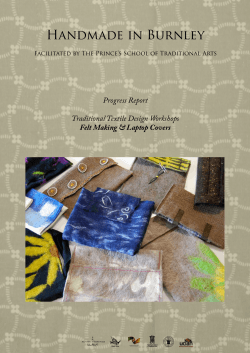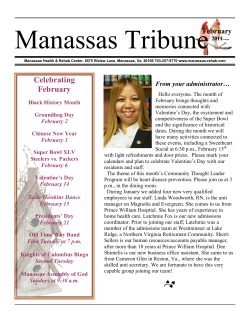
Handmade in Burnley Progress Report Traditional Textile, Design & Make Workshops
Handmade in Burnley Facilitated by The Prince’s School of Traditional Arts Progress Report Traditional Textile, Design & Make Workshops Felt Making & Laptop Covers October 11th-14th 2010 November 8th-11th 2010 Altajir Trust The Prince’s School of Traditional Arts The Prince’s School of Traditional Arts Workshops overview In October 2010 the Prince’s School of Traditional Arts started a new set of workshops designed to deepen and expand the felt making techniques taught on previous sessions. For this phase the school brought in a new teacher and textile professional, Amanda Horning to lead the participants into designing and making high quality prototypes and products. During two workshops in October and November, Amanda and the rest of the team guided the participants through exercises in colour harmonies, composition, as well as talking about the choice of fabrics for different purposes and demonstrated a variety of felt making techniques leading up to the making of a product. The first of the colour exercises achieved its aims and helped the participants who come from different backgrounds to work as a group, mixing and moving around the room and talking about the results together. They enjoyed experimenting and ‘playing’ with the colour swatches especially knowing that there was no right or wrong way to put the fabrics together. It was a good practical exercise with hands on the fabric and making their own colour palettes. The aim of getting them to play and evaluate their designing as they worked was very successful. The different progressive exercises addressed the different levels of ability in the group. The sense of achievement and building of self-confidence was evident in the individuals at the end of the day, and the tutors were able to assess the cutting, sewing, and colour-working skills of the individuals. Altajir Trust The Prince’s School of Traditional Arts Visit to Gawthorpe Hall Museum On the first day of the October workshop we visited the extensive textile collection at Gawthorpe Hall museum in Burnley.It was very good to start the workshop with this visit with all its wonderful inspirational exhibits. It was a good point of reference for the rest of the workshop. We intend to carry on drawing inspiration from these pieces for both design and technique and guide our workshop participants into studying and interpreting the motifs found in the collection. This is a rich addition to the textile collection in Towneley Hall museum, thus expanding even further on our local research and inspiration for the products to come. The Prince’s School of Traditional Arts Colour blending of wool fibres The first technique taught on this workshop was colour blending. For inspiration Amanda drew the participants attention to contemporary fashion items as well as traditional painters like Turner, who with his distinct vision of colour harmonies and blended tones provided a wonderful inspiration. In this way we invited the participnats to look at different mediums as well as the natural environment for their colour references. After a demonstration on how to use colour and tones in order to create a smooth blending effect, everyone made a sample piece with wonderful colour blending using the given wool fibres. Some of the students managed to add a blended tones sample to their collection with the natural wool colours. Altajir Trust The Prince’s School of Traditional Arts Design elements transferred onto felt On the second day, a different felt effect (wet-outline) was demonstrated and everyone had the opportunity to use the exhibits from either Towneley or Gawthorpe Halls as inspiration for their designs for this felt sample. All, individually, were taken through the conscious design process of inspiration, design, review, redesign, paper mock-up to final felt sample. Following from the museum visit earlier in the week some of the participants also experimented with embroidery techniques to explore the embellishment of their final product. The Prince’s School of Traditional Arts Altajir Trust The Prince’s School of Traditional Arts Designing and making the final felt piece We looked at the shape and layout for the felt fabric design in relation to its final use for a bag or cover for a laptop. Using their knowledge of designing and the different effects they could now create in felt, they designed on paper, a larger piece of felt for their laptop covers. The large pieces of felt were set out and started. All students gained more control over their felt production; from their inspiration point to a design in felt suitable for their chosen product. Small sample bags were made by some of the students. By the end of the four days they had put together a blend of felt fibres in subtle tone blending and colour blending, created a pattern with the wet outline technique and started their large piece of felt from their paper design. Their confidence and sense of satisfaction had grown and so too their willingness to learn to improve their work. The Prince’s School of Traditional Arts Altajir Trust The Prince’s School of Traditional Arts C O N TA C T I N F O R M AT I O N Dr. Khaled Azzam, LVO Director Patricia Araneta Outreach Programme Director The Prince’s School of Traditional Arts 19-22 Charlotte Road London EC2A 3SG Tel + 44(0)20 7613 8500 Fax+ 44(0)20 7613 8558 www.psta.org.uk The Prince’s School of Traditional Arts is a company limited by guarantee, no 4970959. Registered in England and Wales. Registered charity no 1101527. The Prince’s School of Traditional Arts
© Copyright 2025





















